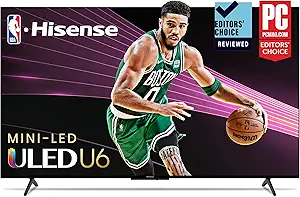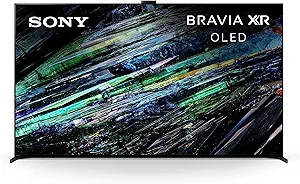Sony and Hisense are both prominent brands in the television industry, each bringing their unique technologies and features to the table. Sony Televisions, a Japanese brand, is renowned for its advanced technologies such as OLED and LCD, which offer exceptional picture quality. The brand's latest models, such as the Sony Bravia XR A90J, are equipped with Cognitive Processor XR technology, which is designed to deliver an immersive viewing experience by understanding how humans see and hear. On the downside, Sony televisions are typically more expensive than other brands, which may deter budget-conscious consumers. On the other hand, Hisense, a Chinese brand, has also made significant strides in the television market. Known for their affordability and value, Hisense TVs often come with features such as 4K resolution, HDR, and smart TV capabilities that are comparable to higher-end brands. One of their latest models, the Hisense U8G, utilizes Quantum Dot technology and Full Array Local Dimming, offering excellent picture quality at a lower price point. However, the brand has been criticized for its less intuitive user interface and weaker audio quality compared to other brands like Sony. Despite these differences, both Sony and Hisense continue to innovate and provide a range of options for consumers with varying preferences and budgets.
Key Features Comparison
Picture Quality
Top-Rated Picture Quality Brands
Sony Televisions are renowned for their picture quality, primarily due to their advanced technologies such as X-Reality Pro, Triluminos Display, and 4K HDR Processor X1. The X-Reality Pro enhances the detail of every scene, while the Triluminos Display reproduces more colors than a conventional television. The 4K HDR Processor X1, on the other hand, offers deep black and vibrant color contrast. However, Sony TVs are generally more expensive compared to other brands, which may not be ideal for budget-conscious consumers. On the other hand, Hisense televisions also offer good picture quality at a more affordable price point. They use technologies such as Ultra Smooth Motion, ULED, and Dolby Vision HDR to enhance the viewing experience. Ultra Smooth Motion reduces motion blur and makes fast-moving scenes appear more fluid. ULED technology improves color, contrast, brightness, and smooth motion. Dolby Vision HDR provides extraordinary color, contrast, and brightness to the screen, making pictures more lifelike. However, while Hisense TVs offer good value for money, they may not match the superior picture quality of Sony TVs, especially in terms of color reproduction and contrast.
Design
Sony and Hisense televisions both have unique design aspects that set them apart in the market. Sony televisions are known for their sleek, modern designs that blend seamlessly into any home decor. The latest models, such as the Sony Bravia XR A90J, feature an ultra-slim design with a minimalist stand and virtually no bezel, giving the illusion of a floating screen. The high-quality materials used in Sony's designs not only enhance the aesthetic appeal but also contribute to the durability and longevity of their products. However, Sony’s high-end design often comes with a high-end price tag, which may not be feasible for all consumers. On the other hand, Hisense televisions, like the Hisense U7G, also offer a modern, sleek design but at a more affordable price point. Hisense designs often include slim bezels and stands, similar to Sony, but may lack the premium materials and ultra-slim profiles of their higher-priced competitors. However, Hisense has made significant strides in their design approach, incorporating technologies like ULED and Quantum Dot for better picture quality, which is a great value-addition considering their price range. While Hisense may not have the same brand prestige as Sony, their designs are competitive and offer a good balance between aesthetics and affordability.
Sound
Top-Rated Sound Quality Brands
Sony televisions are renowned for their superior sound quality, which is largely attributed to their Acoustic Surface Audio technology. This technology produces sound from the entire screen, resulting in an immersive, cinema-like audio experience. Sony TVs also feature Dolby Atmos, which enhances the sound clarity and depth, delivering a three-dimensional sound that flows all around you. However, the high-quality sound experience offered by Sony TVs comes at a higher cost compared to other brands. On the other hand, Hisense televisions, while being more budget-friendly, also offer decent sound quality. Their latest models come with Dolby Atmos technology, which provides clear, immersive sound. However, the sound quality might not be as rich or as full as Sony's, especially in larger rooms or open spaces. Some users have noted that Hisense TVs may require an additional soundbar or speaker system for a more robust audio experience. Despite this, Hisense TVs offer good value for money, especially for those who prioritize affordability over top-tier sound quality.
Quality & Performance
Sony televisions, known for their high-quality displays and excellent performance, are often equipped with the latest technologies like 4K HDR, OLED, and QLED panels. The brand's X1 Ultimate Processor, found in their high-end models, delivers powerful real-time image processing for ultra-detailed pictures. Sony's Acoustic Surface Audio technology is another notable feature, which produces sound from the screen itself, creating an immersive viewing experience. However, Sony TVs tend to be more expensive than other brands, which might be a downside for budget-conscious consumers. On the other hand, Hisense televisions offer a good balance between quality and affordability. They also offer 4K and QLED technologies, but at a more accessible price point. Hisense's ULED technology, exclusive to the brand, enhances color, contrast, brightness, and smooth motion. The brand's VIDAA U Smart TV platform is user-friendly and responsive, although it doesn't support as many apps as Sony's Android TV platform. Hisense TVs may not match the premium build quality of Sony, but they provide good performance and value for money, making them a viable option for those looking for a budget-friendly alternative.
Smart TV & Connectivity
Sony televisions are renowned for their smart TV and connectivity features. They come equipped with the latest Android TV platform, which offers a wide range of apps from Google Play Store, including streaming services like Netflix, Amazon Prime, and Disney+. In terms of connectivity, Sony TVs support HDMI 2.1, Wi-Fi, and Bluetooth 4.2, offering seamless connection with various devices. They also support Apple AirPlay 2 and HomeKit, making it easier for Apple users to connect and share content. However, some users have reported that the Android TV platform can be a bit slow and complex to navigate. On the other hand, Hisense televisions also offer smart TV features, but they use their own Vidaa U platform. This platform is simpler and more straightforward to use than Android TV, but it doesn’t have as many apps available. For connectivity, Hisense TVs also support HDMI, Wi-Fi, and Bluetooth, but they lack the support for Apple AirPlay 2 and HomeKit. This could be a drawback for Apple users. However, Hisense TVs are generally more affordable than Sony TVs, making them a good choice for budget-conscious consumers. Overall, both brands offer robust smart TV and connectivity features, but Sony has a slight edge in terms of app availability and support for Apple services.
Brand Reputation
Sony has long been recognized as a leader in the television industry, boasting a reputation for high-quality products with advanced technologies. Their televisions are known for their superior picture and sound quality, with models like the Sony Bravia utilizing technologies such as OLED and 4K HDR for an enhanced viewing experience. Sony's reputation is also bolstered by their consistent innovation, with their latest models featuring smart capabilities, Google Assistant integration, and even 8K resolution. However, Sony televisions are often more expensive than other brands, which can be a deterrent for some customers. On the other hand, Hisense, a Chinese brand, has been steadily gaining recognition in the television market. While not as established or widely recognized as Sony, Hisense has made a name for itself by offering affordable televisions without compromising on quality. Their televisions often feature 4K resolution, smart capabilities, and technologies like ULED and Dolby Vision HDR, similar to Sony. Hisense's reputation is growing due to their commitment to providing value for money, offering features and technologies comparable to more expensive brands at a lower price point. However, some customers have reported issues with the longevity of Hisense televisions, which may impact their reputation in the long run.
Brightness
Sony televisions, particularly those in the Bravia series, have been lauded for their exceptional brightness and contrast levels. The latest models feature Sony's X-tended Dynamic Range PRO technology, which uses a unique algorithm to enhance brightness and darkness in an image, providing a wider range of brightness than traditional LED televisions. Sony also uses Full Array Local Dimming technology, which allows for precise control of the light output, thus enhancing the brightness where it's needed. However, these features often come at a premium price, making Sony TVs more expensive than many other brands. On the other hand, Hisense televisions, specifically the ULED range, offer impressive brightness levels at a more affordable price point. Hisense uses Quantum Dot technology and Full Array Local Dimming, similar to Sony, to enhance the brightness and contrast of their televisions. The latest Hisense models also feature Dolby Vision HDR, which dynamically enhances brightness levels on a scene-by-scene basis. However, some users have noted that the brightness levels on Hisense TVs can sometimes result in over-saturation of colors, which can affect the overall picture quality. Compared to Sony, Hisense televisions offer a more budget-friendly option for high brightness levels, but may not provide the same level of color accuracy.
Smart Features
Sony and Hisense televisions both offer a range of smart features, but they differ in terms of user interface, app availability, and voice control functionality. Sony televisions, running on Google's Android TV platform, provide access to a vast array of apps through the Google Play Store. This includes popular streaming services like Netflix, Amazon Prime Video, and Hulu, as well as a variety of games. The platform also supports Google Assistant, allowing for voice control and integration with other smart home devices. However, some users have reported that Sony's interface can be somewhat complex and slow. On the other hand, Hisense televisions use their proprietary Vidaa U platform for their smart features. The interface is simpler and more straightforward compared to Sony's, making it easier for users to navigate. However, the app selection is more limited, with some notable streaming services missing. Hisense TVs also support voice control, but only through Amazon's Alexa, which may not be as convenient for users who are already invested in the Google ecosystem. In terms of speed, Hisense's interface is generally reported to be faster and smoother than Sony's. Both brands have their strengths and weaknesses, and the choice between them may come down to personal preference and specific user needs.
Remote Control
Sony and Hisense are both reputable brands in the television industry, each with its unique remote control design and features. Sony's remote controls are typically equipped with the latest technologies, such as voice control and direct access buttons to popular streaming services like Netflix and Amazon Prime. They are often praised for their ergonomic design and intuitive button layout, making them user-friendly. However, some users have reported that Sony's remote controls can be slightly larger and heavier than average, which may not be comfortable for all users. On the other hand, Hisense's remote controls are also equipped with modern features such as voice control and one-touch access buttons to streaming services. They are known for their lightweight and compact design, which many users find convenient and comfortable to use. However, some users have reported that the button layout on Hisense's remote controls can be less intuitive than Sony's, which may require a slight learning curve for new users. Also, Hisense's remote controls may not feel as robust or durable as Sony's. Comparatively, both brands offer feature-rich remote controls, but user preference may vary depending on factors like design, weight, and button layout.
Related Video
Conclusion
Sony and Hisense televisions both offer a range of features that make them competitive in the current market. Sony, a well-established brand, is known for its innovative technologies such as the X-Reality PRO picture processing engine, Triluminos Display for a wider color range, and the Android TV platform for smart TV capabilities. These features provide high-quality picture and sound, making Sony TVs a popular choice among consumers. However, they tend to be more expensive compared to other brands. On the other hand, Hisense, a relatively newer brand, offers televisions with impressive features at a lower price point. Hisense TVs come equipped with technologies like ULED (Ultra LED) for enhanced picture quality, Dolby Vision HDR for improved brightness and contrast, and VIDAA U for smart TV capabilities. While Hisense may not have the brand recognition of Sony, its televisions offer great value for money, making them a strong contender in the market. However, some users have reported issues with the longevity and reliability of Hisense TVs. Therefore, while Sony televisions may come with a higher price tag, they are often associated with better quality and durability.



















